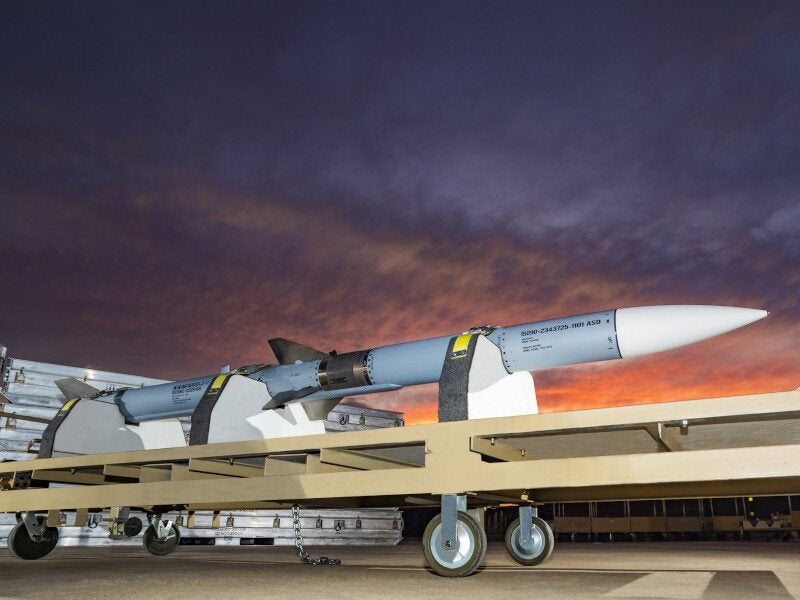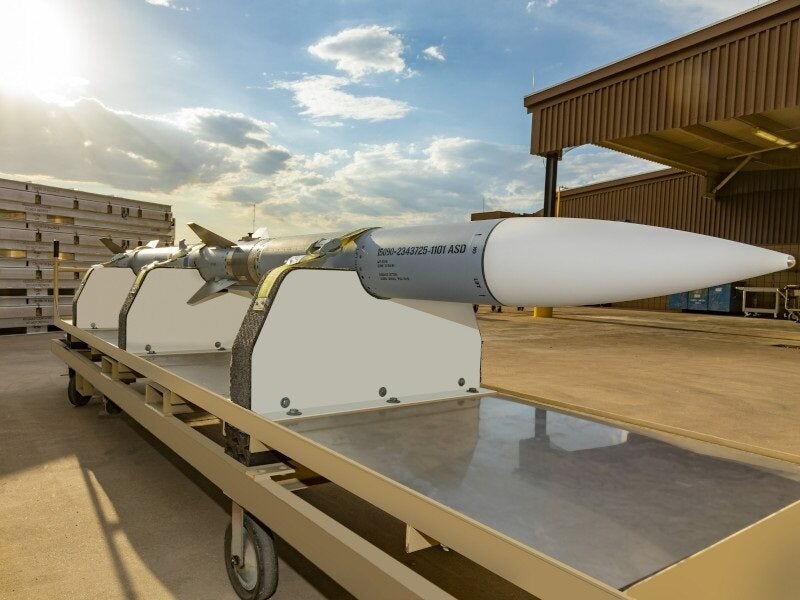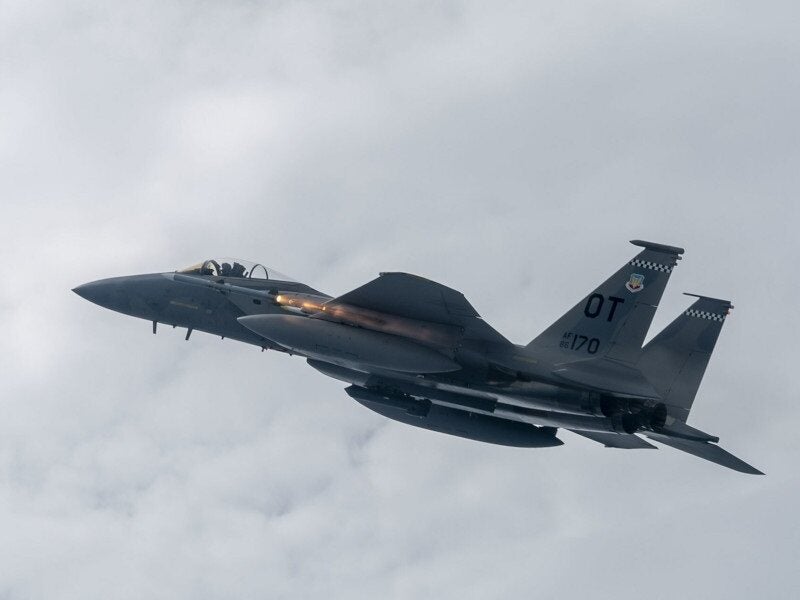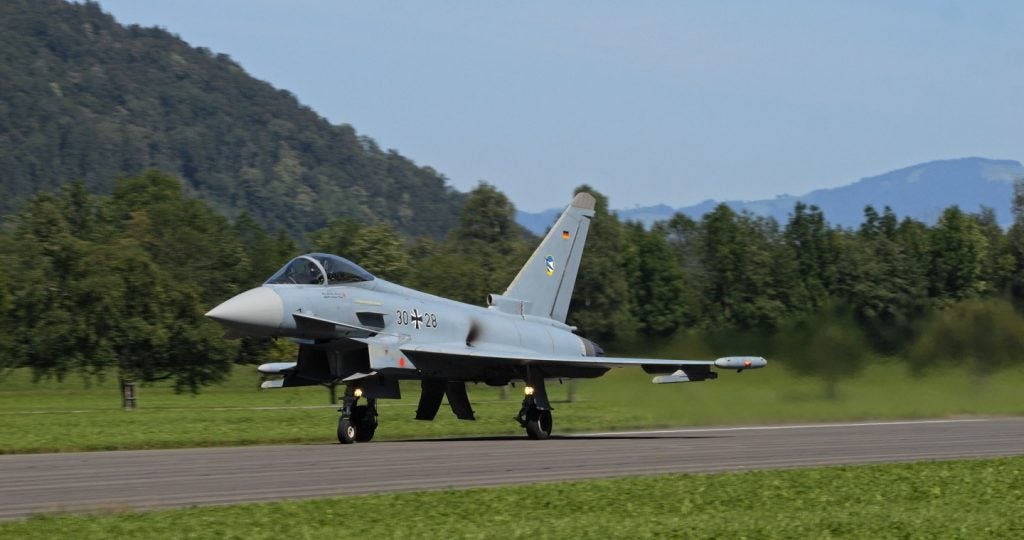AIM-120 advanced medium-range air-to-air missile (AMRAAM) is a new generation, all-weather missile manufactured by Raytheon, a part of RTX.
The AMRAAM is in service with the US Air Force (USAF), US Navy (USN), and US-allied nations. It has been delivered to more than 36 countries and has completed more than 1.8 million captive-carry hours and 2,900 live firings.
The missile is integrated with combat aircraft such as the F-15, F-16, F/A-18, F-22, Typhoon, Gripen, Tornado, Harrier, F-4, and the F-35 Joint Strike Fighter. It is also used by the Surface-Launched AMRAAM of the US Army and NASAMS (Norwegian Advanced Surface to Air Missile System).
AIM-120 AMRAAM development
The AMRAAM is a joint USAF and USN programme led by the US Air Force. The conceptual phase of the programme was completed in February 1979 when Hughes Aircraft and Raytheon were selected as preferred contractors by the USAF to continue into the validation phase.
The programme was concluded with the successful demonstration of flight tests in December 1981. Hughes Aircraft’s Missile System Group was preferred as the full-scale developer of the missile. The development was concluded during the full-scale development phase.
Raytheon was chosen as a follow-on manufacturer. The production contract was awarded to both companies in 1987. More than 200 missiles were test-fired during the flight tests.
In February 2012, communications company Harris won a $11m follow-on contract from the USAF to provide warhead replacement tactical telemetry modules (WRTTM) for the AMRAAM. The contract increased the total contract value under the WRTTM programme to more than $181m since 1991.
Design features
Derived from the Sparrow range of missiles, the AMRAAM was designed to be quicker, smaller, and lighter than the Sparrow. The missile’s layout is divided into guidance, armament, propulsion, and control sections. The missile has beyond-visual-range and home-on-jamming capabilities.
The AMRAAM has a length of 3.6m, diameter of 17.7cm, and wingspan of 52.5cm. The launch weight of the missile is 150.7kg. It can carry an 18.1kg high-explosive blast fragmentation warhead to a maximum range of between 20nm to 30nm.
AIM-120 AMRAAM variants
The AIM-120A is the first variant, which is no longer in production. The AIM-120B is an improved variant introduced in 1994. The AIM-120C has smaller control surfaces to enable the internal carriage on the F/A-22 aircraft and carries an improved warhead. It was further upgraded to create a new variant called AIM-120C-7, which was successfully tested in 2003.
The AIM-120D is the newest member in the family of AMRAAM. The variant completed its seventh test flight in May 2009 and integrates advanced hardware and software systems for improved navigation, range, and HOBS capability. The FOT&E of the AIM-120D variant was finished in July 2014 and a total of 1,031 AIM-120D missiles were delivered for the USAF and US Navy by October 2014.
The new AMRAAM-Extended Range missile is designed for ground-based air defence with integration of the NASAMS launcher. In the second quarter of 2021, the first flight test of the missile was successfully accomplished.
The most sophisticated version of the AMRAAM family, the AIM-120D-3, was created as part of the F3R programme, with the ability to counter peer threats. It features 15 upgraded circuit cards in the missile guidance section and can continuously upgrade future software enhancements. The variant is installed with the latest System Improvement Program-3F software and F#R hardware. The missile’s first AMRAAM F3R, live fire test was conducted in June 2022.
The Functional Configuration Audit of AIM-120D-3 was completed in April 2023 by the USAF. In July 2023, the USAF and Raytheon successfully completed the operational and developmental testing of the variant by firing from the F-16.
In September 2023, the first flight test of the AIM-120D-3 was completed by firing from a F-15C Eagle.
Guidance and navigation
The AIM-120 AMRAAM receives information about the location of the target from the aircraft before its launch. The onboard active radar with inertial navigation system makes the missile less dependent on the aircraft’s fire control radar and integrates a datalink to guide the missile. Once the missile closes to self-homing distance, the active radar guides it towards the target. This feature provides fire-and-forget capability to the missile and allows the pilot to fire a number of missiles simultaneously at multiple targets.
Propulsion
The AIM-120 AMRAAM is powered by a high-performance rocket motor using reduced smoke hydroxyl terminated polybutadiene propellant. The motor is housed in a WPU-6/B propulsion unit.
An alternative rocket motor for the AIM-120 AMRAAM is being developed by Raytheon and the Norwegian defence company, NAMMO.
AIM-120 AMRAAM international orders and deliveries
In August 2004, the UK Ministry of Defence (MoD) placed a $144m contract with Raytheon for the latest AIM-120 C5 variant. Raytheon received a $200m contract from the USAF for 434 missiles in December 2004.
The Pakistan Air Force placed an order in early 2006 for 500 AIM-120C-5 AMRAAM missiles under its $650m F-16 ammunition contract.
In September 2006, the USAF placed a $66m foreign military sales (FMS) contract to deliver 123 AIM-120C5 missiles for Saudi Arabia and Singapore. Poland received the AIM-120C-5 missiles for its new F-16 fighters in 2006.
In 2007, the US government agreed to sell 218 AIM-120C-7 missiles to Taiwan under a $421m arms sales package. The Finnish MoD placed an order for 300 AMRAAMs in 2008. Deliveries have been delayed due to the malfunction of rocket motors during cold weather tests.
In November 2009, the US government exercised separate letters of offer and acceptance with three of its allies, Kuwait, Morocco, and Jordan, for the AIM-120C-7 AMRAAM. Chile requested a sale of 100 missiles in November 2009. Switzerland requested a sale of 150 missiles in December 2010.
Raytheon received a $768m contract from the USAF for production Lot 33 of the missiles, in December 2019. The contract includes the production of AMRAAM missiles, captive air training missiles, guidance sections, AMRAAM telemetry system and support hardware.
The USAF awarded a contract modification worth $573m to the company to continue its works for building AMRAAM, in March 2016.
The US State Department approved the request of the Polish government for the purchase of 150 AIM-120C-7 missiles for $250m in November 2017. The UK government’s request for the procurement of up to 200 AMRAAM AIM-120D missiles was approved in July 2018. Hungary will purchase 180 AIM-120C-7 missiles in a deal estimated at $500m.
In October 2019, the US government approved a potential sale of 120 AIM-120C-7/C-8 AMRAAMs, along with containers, spares and support equipment to South Korea. The US State Department also cleared the sale of 118 AIM-120C-7/C-8 missiles as part of an integrated air defence weapon system to India in February 2020.
The USAF awarded a $972m contract to Raytheon in August 2022 for the upgradation of hardware and software of the AIM-120D3 and AIM-120C8 missiles.
RTX received a $1.15bn contract from the USAF for the production of AIM-120 D-3 and C-8 missiles in June 2023. It is the fifth lot of production under the Form, Fit, Function Refresh programme.
In July 2023, the US State Department approved an FMS to the government of Sweden for 250 AIM-120C-8 missiles, six AMRAAM C-8 guidance sections with AIM 120 control sections, containers and AMRAAM Test Set telemetry kits. The military sale is worth $605m.
In September 2023, the US government awarded a $192m contract to Raytheon for the purchase of AMRAAM. Ukraine will receive the missiles as part of a $7.6m Fiscal 2023 Ukraine Security Assistance Initiative funds.
Contractors involved
Signal Technology received a contract for producing oscillators for the AMRAAM in May 2003.
L-3 Communications’ Electron Devices division secured a $6.9m, six-year contract from Raytheon for the delivery of travelling wave tubes for the missile for the period starting 2003 through 2008.









